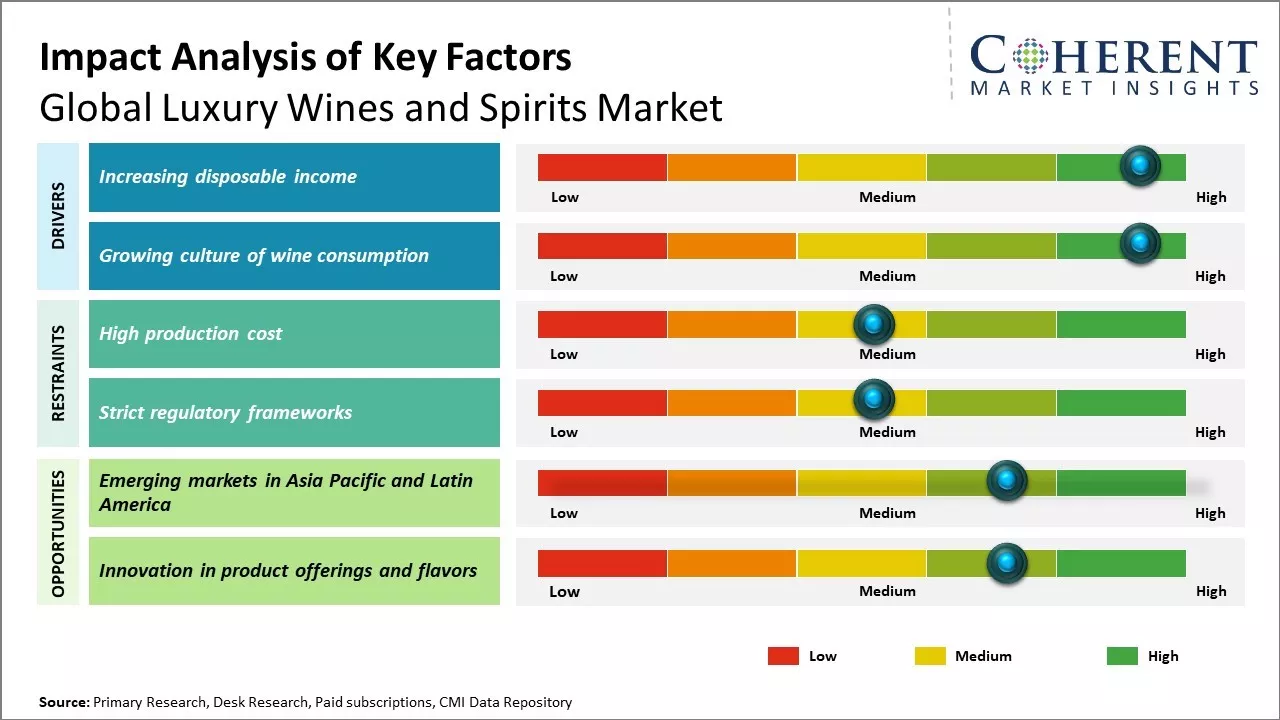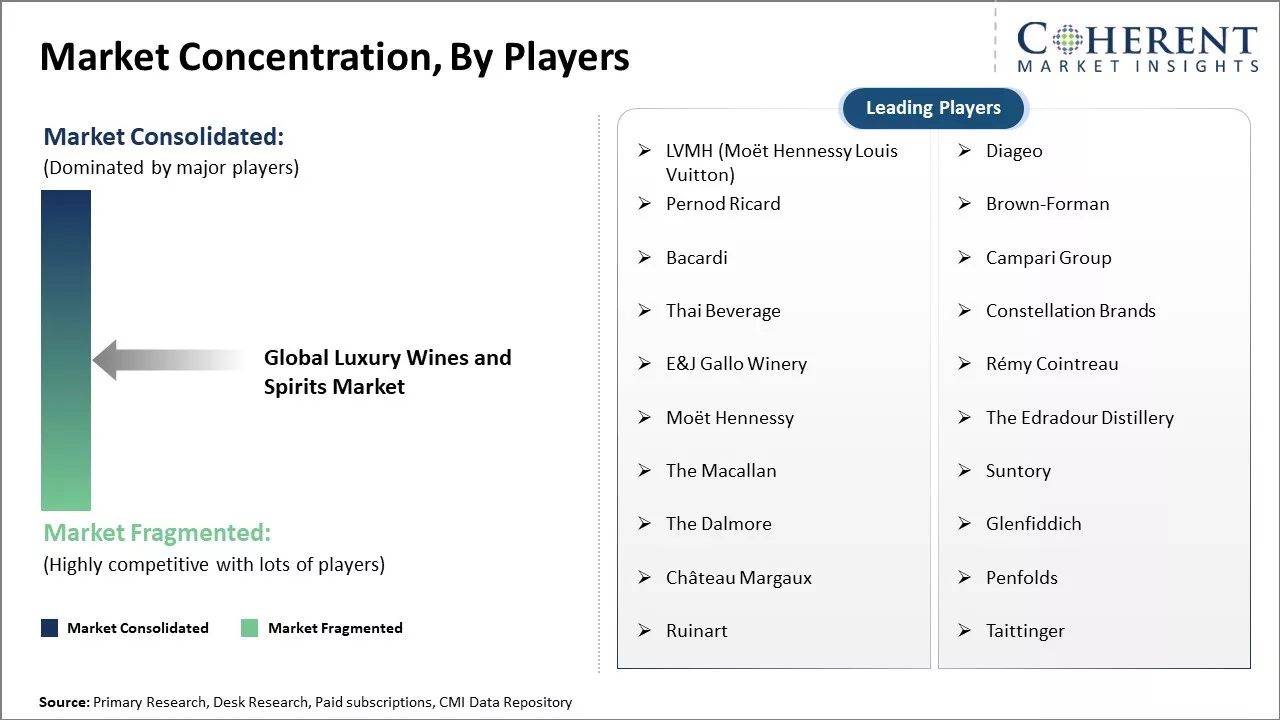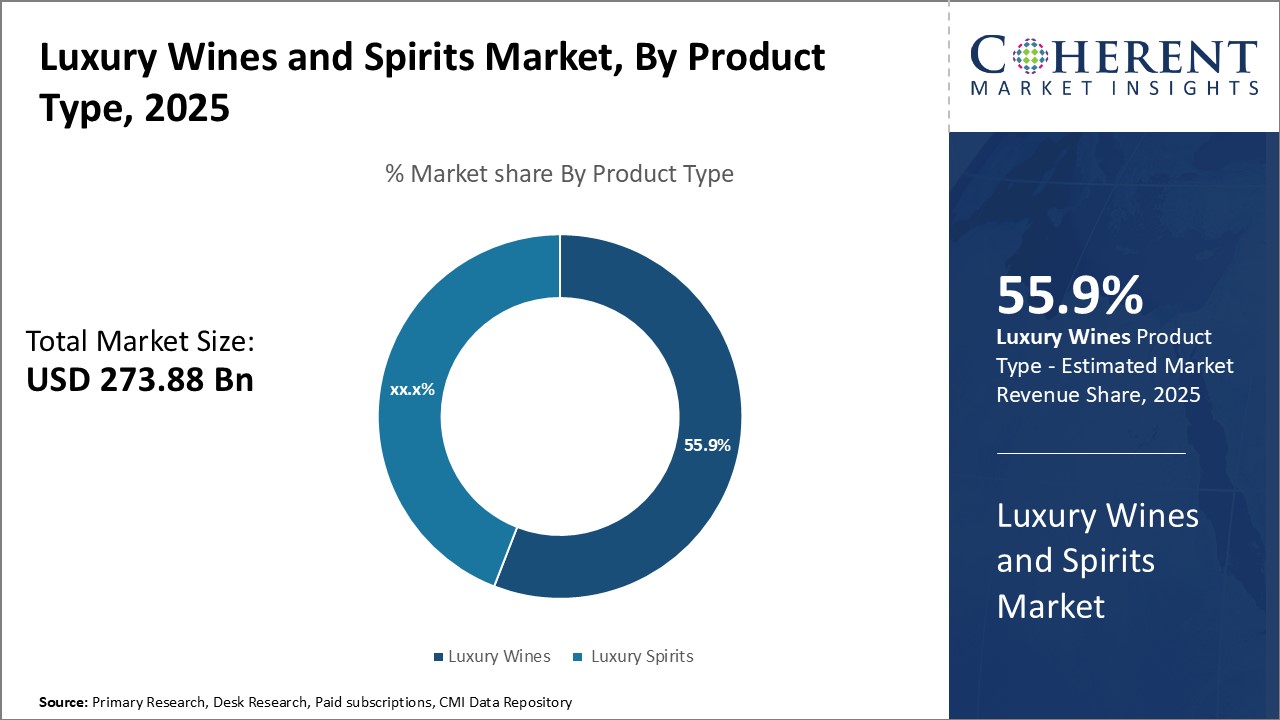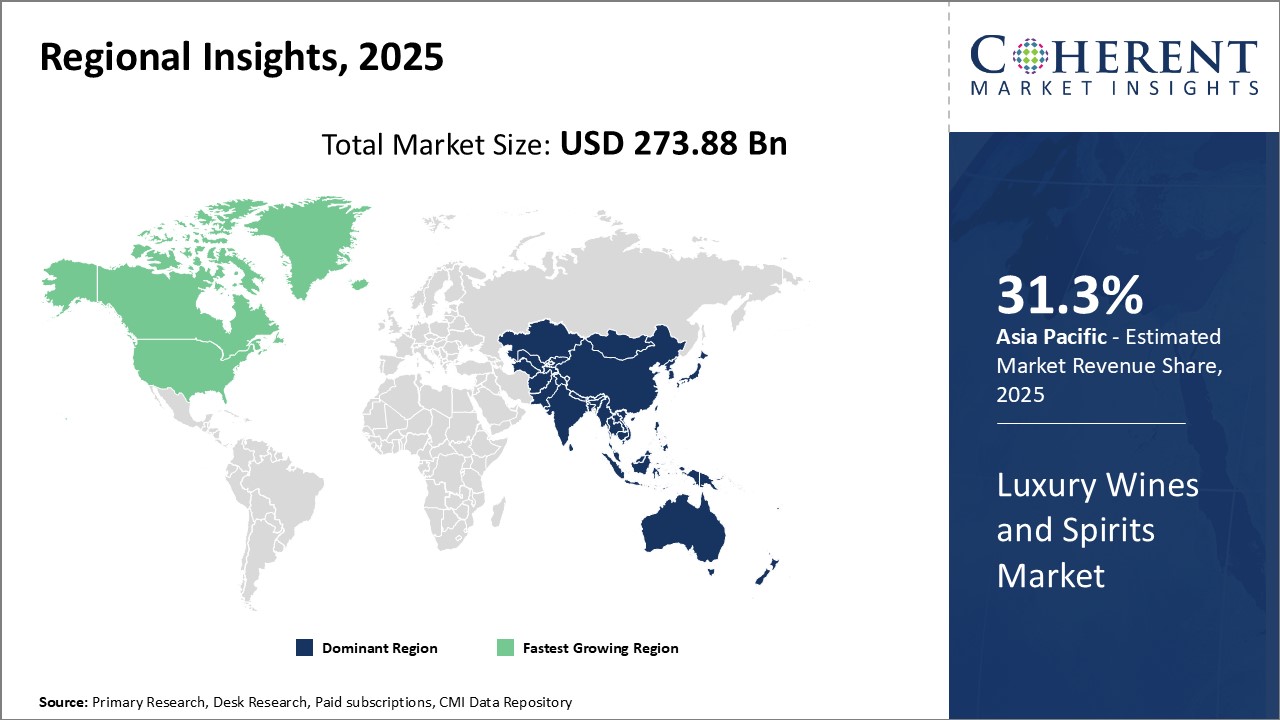Luxury Wines And Spirits Market Size and Trends
Global Luxury Wines and Spirits Market is estimated to be valued at USD 273.88 Bn in 2025 and is expected to reach USD 377.99 Bn by 2032, exhibiting a compound annual growth rate (CAGR) of 4.7% from 2025 to 2032.

Discover market dynamics shaping the industry: Download Free Sample
The luxury wines and spirits sector has been experiencing steady growth over the past few years and this trend is expected to continue during the forecast period owing to rising disposable incomes and changing lifestyle preferences among consumers globally. The market is driven by growing demand for high-end and premium beverage products from consumers. Younger consumers are increasingly willing to spend more on luxury brands and unique tasting experiences. Moreover, the market continues to be influenced by trends like health and wellness, sustainability, and local and artisanal productions which are driving innovations in the luxury wines and spirits landscape. Regions like Asia Pacific are witnessed strong growth opportunities due to rising affluence.
Increasing disposable income
As the economies around the world are growing steadily, more people are getting higher paying jobs which allows their disposable income to rise. For instance, according to data by Economics Times in March 2025, India's Gross National Disposable Income (GNDI) grew 14.7% in 2022-2023, compared to 18.8% in 2021-2022. This is especially true for developing nations like China, India, and other Southeast Asian countries where middle class population is burgeoning. As people earn more, their spending on luxury and premium goods rises sharply. Luxury wines and spirits certainly fall under this category. Over the past decade, countries like China have seen unprecedented economic growth and rise in GDP per capita. Similarly other emerging markets are also recording higher GDP growth rates. This increased affluence directly helps the luxury wines and spirits market.
Now people in these nations can afford to splurge on premium imported wines from places like France, Italy, U.S., etc. Not just wines, even luxury spirits like scotch, whisky, cognac, and Japanese whiskeys are in demand. Young professionals and wealthy individuals make it a habit to gift, entertain or personally consume high-end alcoholic drinks to flaunt their status symbol. The desire to attain lifestyle symbols of the rich and famous drives much of this premium consumption. Wine being relatively less expensive luxury item compared to others has found more takers from new money crowd wanting to experience finer things in life. At lavish house parties, getting togethers and formal dos, it has become quite normal to serve expensive French champagnes and Californian cabernet sauvignon wines.
Market Concentration and Competitive Landscape

Get actionable strategies to beat competition: Download Free Sample
Growing Culture of Wine Consumption
Wine has come to occupy an exalted position not just as beverage but also as a marker of refined taste and symbol of status. Especially in the Western world, wine consumption is deep-rooted in the culture and lifestyle. Countries like France, Italy, Spain have been historically renowned for their beautiful vineyards and variety of indigenous grape varietals produce. New World wines from the U.S., Australia, New Zealand, and South Africa have also established strong footing over last few decades. This enduring romance with wine has soaked into global popular culture through movies, TV shows, music, and travel. Images of people casually enjoying wine with friends, on romantic dates or at lavish dinner parties promote the high-living culture associated with it.
Younger generations growing up exposed to these influences are keen to emulate the same. They want to impress friends and partners by displaying flair for wines over regular beer and cocktails. Wine tourism has balloomed with more young travelers keen to visit famous wine regions. They come back eager to showcase their newfound knowledge. Online reviews, blogs focused on exotic wines has made oenophiles out of ordinary folks as well. Interest in obscure organic, biodynamic vintages is also rising. More restaurants, even casual dining ones now offer expensive wine menus and pairings over whiskey or other spirits focused beverages.
Wine education programs, sommelier certifications, and expert vintner talks only serve to elevate the prestige attached to wines. What was once an elite world is fast becoming part of mainstream social experience. This growing passion particularly in younger cohort bodes well for the luxury wine segment. Curiosity drives experimentation with premium bottlings outside regular wine drinking regions. Such cultural shifts prove instrumental in keeping demand vibrant for the luxury wines globally.
Key Takeaways from Analyst:
One of the key drivers for the market's growth is the rising disposable incomes and growing consumption of luxury alcoholic beverages among high-net-worth individuals globally. Another factor aiding the market expansion is the increasing social acceptability of alcohol consumption in developing regions. While North America and Europe currently dominate the luxury wines and spirits market, regions such as Asia Pacific are expected to emerge as the fastest growing market.
One of the major restraints affecting the market is the higher taxation and regulatory stringent imposed on alcoholic beverages in various countries India and other. Significant cultural and religious restrictions on alcohol consumption in certain parts of the Middle East and Asia Pacific also hinders the market's growth prospects. However, improving distribution channels and rising number of licensed stores selling luxury wines and spirits presents an opportunity for marketers to tap new customers worldwide.
Ongoing innovation and introduction of novel flavors and organically produced luxury alcoholic beverages will likely bolster global demand. The market players’ focus on strengthening their footprint in developing markets offers promising growth opportunities. Premiumization trend and focus on marketing exotic varieties through exclusive tasting events and shows also works in favor of luxury wines and spirits companies.
Market Challenge - High production cost
One of the key challenges for the global luxury wines and spirits market is the high production costs associated with these premium beverages. Luxury wines and spirits often involve labor-intensive production techniques and the use of high-quality ingredients sourced from specific regions which drive up costs. Producing small batches and maintaining strict quality standards throughout the production process adds further costs for manufacturers. Additionally, aging requirements for some luxury spirits mean companies must tie up capital for longer periods as inventory sits in barrels or other storage facilities for years before being ready for sale. With commodity inputs like grapes and grains subject to price fluctuations due to variables like weather, production costs can be difficult to predict accurately. High costs limit the customer base that can afford these luxury beverages and put pressure on companies to price products at luxury price points. This makes the market highly sensitive to economic conditions and risks deteriorating sales when discretionary spending decreases.
Market Opportunity - Emerging Markets in Asia Pacific and Latin America
One major opportunity area for the global luxury wines and spirits market lies in emerging economies in regions like Asia Pacific and Latin America. These developing markets are seeing rising disposable incomes and a rapidly expanding population of wealthy individuals who admire Western luxurious lifestyles. There is growing demand from prestige-conscious middle and upper-middle class consumers for premium imported wines and spirits to serve at social gatherings and gift-giving occasions. Companies that can establish early brand recognition and distribution in these emerging luxury goods hubs will be strategically positioned for future growth. An increased focus on emerging markets will help offset risks from market saturation in traditional luxury strongholds. If producers successfully cultivate new luxury clientele overseas, it will open up huge potential for higher volume sales and greater market share gains in the decades ahead.

Discover high revenue pocket segments and roadmap to it: Download Free Sample
Insights by product type: Consumer Preferences for Quality and Variety
Within the global luxury wines and spirits market, the luxury wines segment is estimated to hold 55.9% share in 2025. This is primarily due to evolving consumer preferences that favor quality wine products offering distinctive tastes and experiences.
The luxury wine segment benefits from consumers who take pride in developing their knowledge of wine regions, grapes, and winemaking techniques. They enjoy exploring new varietals and vintages that offer novel flavor profiles and complexities only available from high-end wines. Major luxury brands such as Domaine de la Romanée-Conti (Burgundy, France) and other have capitalized on this trend by releasing limited-run or vintage-specific products available only to their most discerning customers, increasing launch of new products by key players is expected to drive the segment growth, for instance, In May 2024, O’Neill Vintners & Distillers, a Certified B Corporation known for its commitment to sustainability and social responsibility, announced the acquisition of the luxury wine estate Ram’s Gate Winery located in Sonoma, California. This strategic move marks a significant expansion for O’Neill Vintners & Distillers, as it aims to enhance its portfolio in the premium wine market.
Insights by distribution channel: Convenience and Experience Fuel Online Retail's Dominance in Distribution
Within the luxury wines and spirits distribution landscape, the online retail segment is estimated to capture 36.1% share of the market in 2025. The segment owes its growth primarily to the convenience and selection it provides to time-pressed consumers.
E-retailers now offer unprecedented access to products from even the smallest producers around the world. Their extensive catalogs free customers from relying solely on local store inventories that may stock primarily large brands. This expanded access to unique items drives exploration and experimentation within the luxury segment.
Another factor in online retail's prevalence is the experience economy. Sites provide immersive content like ratings, ratings, articles, and videos to engage customers and deepen their knowledge. Live streaming and virtual tastings also keep the discovery process entertaining. Social platforms further enhance the online experience through community reviews and recommendations.
Lastly, the global reach of online channels allows international shipping, satisfying customers in locations lacking high-end liqueur and wine boutiques. This accessibility to deliver luxury products anywhere overcomes many geographic constraints seen in brick-and-mortar distribution. As consumer preference for convenience and experiences rise, online retail is well-positioned to continue leading luxury distribution worldwide.
Regional Insights

Need a Different Region or Segment? Download Free Sample
North America has been dominating the global luxury wines and spirits market for decades with 31.3% share in 2025. While other regions like Europe and Asia Pacific are increasingly gaining ground, North America still commands a sizable share due to strong foundations and cultural affinity towards luxury alcohol in the region. The old-world winemaking traditions, protection of geographical indications, and well-structured distribution networks have ensured European brands maintain an edge.
Among the fastest growing regions, globally is Asia Pacific, led predominantly by China. As the largest global market, China offers colossal opportunities for luxury alcohol producers and is increasingly embracing luxury lifestyles including quality wines and spirits. Significant growth in high-net-worth individuals, easing of import regulations and establishment of prestigious brands are fueling serious consumption growth. Chinese consumers especially millennials are eager to try premium international labels and homegrown craft genres are also emerging. The tremendous demand momentum has made Asia Pacific region integral for global players seeking new frontiers of expansion. Quality consciousness is increasing and with rising affluence, the region is primed to potentially overtake others in the coming decade.
Market Report Scope
Luxury Wines and Spirits Market Report Coverage
| Report Coverage | Details | ||
|---|---|---|---|
| Base Year: | 2024 | Market Size in 2025: | USD 273.88 Bn |
| Historical Data for: | 2020 To 2024 | Forecast Period: | 2025 To 2032 |
| Forecast Period 2025 to 2032 CAGR: | 4.7% | 2032 Value Projection: | USD 377.99 Bn |
| Geographies covered: |
|
||
| Segments covered: |
|
||
| Companies covered: |
LVMH (Moët Hennessy Louis Vuitton), Diageo, Pernod Ricard, Brown-Forman, Bacardi, Campari Group, Thai Beverage, Constellation Brands, E&J Gallo Winery, Rémy Cointreau, Moët Hennessy, The Edradour Distillery, The Macallan, Suntory, The Dalmore, Glenfiddich, Château Margaux, Penfolds, Ruinart, and Taittinger |
||
| Growth Drivers: |
|
||
| Restraints & Challenges: |
|
||
Uncover macros and micros vetted on 75+ parameters: Get instant access to report
Luxury Wines and Spirits Industry News
- In January 2024, Free AF, a U.S.-based brand specializing in alcohol-free beverages, announced the launch of its new non-alcoholic Sparkling Rosé, now available at Sprouts Farmers Market locations across the United States.
- In 2023, Mionetto, a drink company, introduced a new line of non-alcoholic sparkling wine, expanding its portfolio to cater to the growing demand for alcohol-free alternatives. This innovative product aims to provide the same celebratory experience as traditional sparkling wine, making it an excellent choice for those seeking a sophisticated beverage without the alcohol content.
- In 2023, Giesen, a New Zealand-based provider of non-alcoholic wine, unveiled its latest offering, Giesen 0% Sparkling Brut. This addition enhances Giesen's diverse non-alcoholic wine range, which also includes options such as 0% Sauvignon Blanc, Pinot Grigio, Riesling, Rosé, and Premium Red.
- On St. Patrick's Day in 2022, Jameson unveiled an exciting new addition to its portfolio: a citrus-flavored whisky that promises to delight fans of both traditional and innovative spirits. These unique whisky features undertones of vanilla and almonds, evoking the classic flavors found in an Old-Fashioned cocktail, making it a versatile choice for various occasions.
*Definition: The global luxury wines and spirits market consists of high-end alcoholic beverages from around the world that are produced in limited quantities and sold at premium price points. This exclusive market caters to high-net-worth individuals and focuses on luxury brands of wines, champagnes, cognacs, whiskeys and other spirits. Some of the top luxury spirit brands dominate this niche market by maintaining strict standards for sourcing of ingredients, production processes and quality control to deliver exquisite tasting and premium drinking experiences to status-conscious consumers.
Market Segmentation
- By Product Type Insights (Revenue, USD Bn, 2020 - 2032)
-
- Luxury Wines
- Red Wine
- White Wine
- Sparkling Wine
- Dessert Wine
- Luxury Spirits
- Whiskey
- Vodka
- Rum
- Gin
- Tequila
- Cognac
- Luxury Wines
- By Distribution Channel Insights (Revenue, USD Bn, 2020 - 2032)
-
- Online Retail
- Specialty Stores
- Supermarkets/Hypermarkets
- Duty-Free Stores
- Bars and Restaurants
- Regional Insights (Revenue, USD Bn 2020 - 2032)
- North America
- U.S.
- Canada
- Latin America
- Brazil
- Argentina
- Mexico
- Rest of Latin America
- Europe
- Germany
- U.K.
- Spain
- France
- Italy
- Russia
- Rest of Europe
- Asia Pacific
- China
- India
- Japan
- Australia
- South Korea
- ASEAN
- Rest of Asia Pacific
- Middle East
- GCC Countries
- Israel
- Rest of Middle East
- Africa
- South Africa
- North Africa
- Central Africa
- North America
- Key Players Insights
-
- LVMH (Moët Hennessy Louis Vuitton)
- Diageo
- Pernod Ricard
- Brown-Forman
- Bacardi
- Campari Group
- Thai Beverage
- Constellation Brands
- E&J Gallo Winery
- Rémy Cointreau
- Moët Hennessy
- The Edradour Distillery
- The Macallan
- Suntory
- The Dalmore
- Glenfiddich
- Château Margaux
- Penfolds
- Ruinart
- Taittinger
Share
Share
About Author
Yash Doshi is a Senior Management Consultant. He has 12+ years of experience in conducting research and handling consulting projects across verticals in APAC, EMEA, and the Americas.
He brings strong acumen in helping chemical companies navigate complex challenges and identify growth opportunities. He has deep expertise across the chemicals value chain, including commodity, specialty and fine chemicals, plastics and polymers, and petrochemicals. Yash is a sought-after speaker at industry conferences and contributes to various publications on topics related commodity, specialty and fine chemicals, plastics and polymers, and petrochemicals.
Missing comfort of reading report in your local language? Find your preferred language :
Transform your Strategy with Exclusive Trending Reports :
Frequently Asked Questions
EXISTING CLIENTELE
Joining thousands of companies around the world committed to making the Excellent Business Solutions.
View All Our Clients
